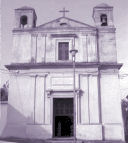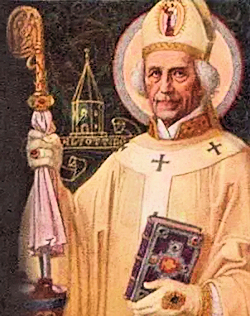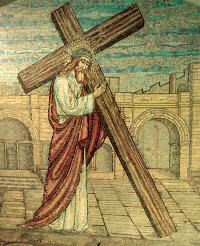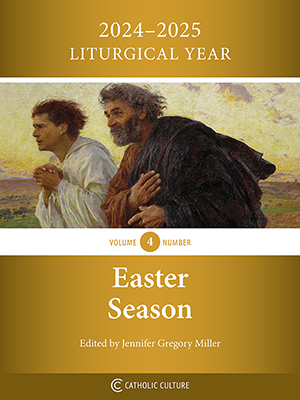Make your gift today!
Help keep Catholics around the world educated and informed.
Already donated? Log in to stop seeing these donation pop-ups.
Lent: March 27th
Thursday of the Third Week of Lent;
Other Commemorations: St. Rupert, Bishop (RM)
» Enjoy our Liturgical Seasons series of e-books!
Today, the mid-point of Lent, was celebrated with somewhat joyful spirit in ancient times. This day was a breathing space in the center of Lent’s austerities. Today’s ancient Entrance Antiphon and Opening Prayer express this encouraging spirit. Modern Lent is less austere, less in need of any breathing space. Today’s lesson: be faithful to God, and do not ever fall away. It is a lesson to strengthen us for the remainder of Lent. —The Vatican II Weekday Missal
The Roman Martyrology today honors St. Rupert (d. 718), Bishop and missionary, also listed as Robert of Hrodbert. A member of a noble Frankish family, he was appointed bishop of Worms, Germany, and then dedicated himself to spreading the faith among the Germans. With the patronage of Duke Thedo of Bavaria, he took over the deserted town of Luvavum about 697, which was renamed Salzburg, Austria. Rupert founded a church, a monastery, and a school; brought in groups of missionaries; and established a nunnery at Nonnberg with his sister, Eerentrudis, serving as the first abbess. He died at Salzburg and is venerated as the first archbishop of this major diocese in the West. Rupert is revered as the Apostle of Bavaria and Austria.
Meditation for Thursday of the Third Week of Lent
The Gospel shows us Jesus at grips with Satan; He overcomes him and drives him from the body of one possessed. From the beginning of His ministry Jesus was pitted against Satan; at the time of His passion He entered on the final combat but victory was assured to Him: "For the prince of this world cometh, and in Me he hath not anything." Our Lord Himself summed up His whole work as the definitive victory over Satan: "Now shall the prince of this world be cast out. And I, if I be lifted up from the earth, will draw all things to Myself."
Thus our Lord's whole mission is set before us as a struggle with, and a victory over, Satan. During Lent the Church could not fail to emphasize this. At the outset, on the 1st Sunday, she appointed for the Gospel the account of the temptation in the desert and we have already seen its real significance. Today, cast out from the body of one possessed, Satan finds that he has lost all the kingdom that he had seized. As the passion and the baptisms of Easter draw nearer it is made clear to us that after the exorcisms pronounced over the catechumens will come the taking possession by Christ of the human souls whom He has redeemed.
The struggle against Satan goes on in our lives as baptized members of the Church. Humanity, so long as it knew not Christ, was deaf and dumb and the devil's prey; but once open to the light of our Savior it can fix its gaze on Him, and strong in His grace, begins on new ways, far from the darkness of sin.
—St. Andrew Daily Missal

Thursday of the Third Week of Lent
Station with Santi Cosma e Damiano (Sts. Cosmas and Damian):
The Station is at the church of Sts. Cosmas and Damian, physicians. These martyrs were twin brothers originating from Arabia. They practiced medicine in Aegea, Cilicia, but accepted no money from the poor. Their beautiful Christian lives edified the pagans and converted many to the Faith. They were arrested in the persecution of Diocletian, subjected to torture, and finally beheaded.
For more on Santi Cosma e Damiano, see:
- Churches of Rome
- The Station Churches
- Rome Art Lover
- Roman Churches
- PNAC
- Aleteia
- Station Church
- The Catholic Traveler
For further information on the Station Churches, see The Stational Church.
St. Rupert of Salzburg
 St. Rupert was the first bishop of Salzburg, who, in some legends, is credited with giving the city its name.
St. Rupert was the first bishop of Salzburg, who, in some legends, is credited with giving the city its name.
Rupert was born in the late seventh century, to a part of the French imperial family. Little is known about his early life, but, like many sons of noblemen, entered the clergy. Rupert was elected bishop of Worms, a German city that was an important seat of power in the Carolingian dynasty.
At first, Rupert's flock welcomed his presence as a caring and faithful bishop. All too soon, however, the relationship between Rupert and the people of Worms soured. Conveniently, a Bavarian Duke, Theodo, asked for Rupert to come south to his palace at Regensburg to come spread Christianity to the diverse tribes he ruled over in Bavaria.
Rupert is often credited with baptizing Theodo, and officially welcoming him into the Church, as the seventeenth-century painting to the left depicts. And with Theodo's blessing, he began his missionary work among the Bavarian tribes.
Rupert found that Bavaria was still, in many ways, truly a wilderness with lots of outbreaks of violence. Thus, Rupert traveled to an old ruined Roman city and renamed it "Salzburg." Rupert founded and rebuilt several different monasteries in the area and lay the foundations of the Salzburg Cathedral. Where, a little over a thousand years later, Wolfgang Amadeus Mozart was baptized.
Rupert died in 710, and there's some dispute whether he had returned back to Worms at the time of his death or whether he died in Salzburg. His successor, Bishop Vergilius of Salzburg, interred his remains in the newly-finished Salzburg Cathedral in 774.
Rupert is known as the "Apostle to the Bavarians" and is a patron saint of Salzburg, Austria, and salt miners.
—Excerpted from Faith ND
Patronage: city of Salzburg, Austria; province of Salzburg, Austria; archdiocese of Salzburg; salt miners
Symbols and Representation: man holding a container of salt (refers to Salzburg and the salt mining there); wearing clerical clothes including mitre; holding a crosier
Highlights and Things to Do:
- Read more about St. Rupert:
- Read about St. Rupert's Fair, the biggest traditional fair in Europe.
- See the Stift St. Peter -- St. Peter's Abby that St. Rupert restored and lived.
- St. Rupert's remains are located at the Salzburg Cathedral at the Volksaltar.






